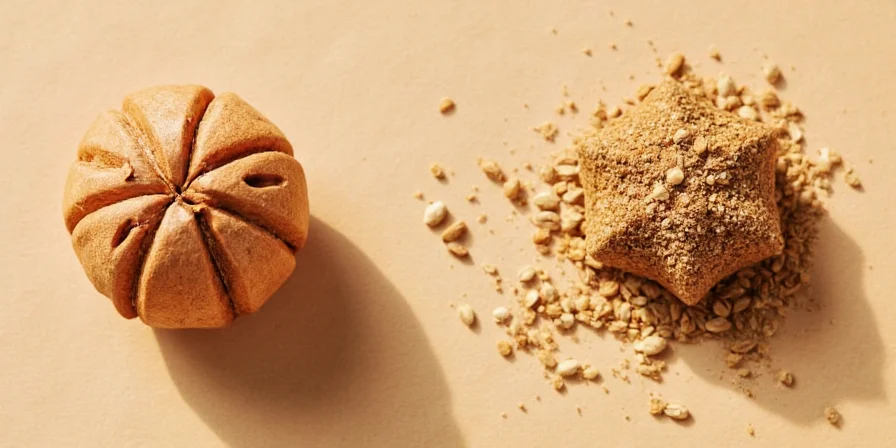Confused about mace vs nutmeg? You're not alone. These spices come from the same plant but have distinct flavors, uses, and values in cooking. Here's what you need to know: Nutmeg is the seed kernel, while mace is the lacy red covering (aril) around the seed. Mace has a brighter, more delicate flavor with citrus notes, while nutmeg is warmer and sweeter. You can substitute mace for nutmeg using a 3:4 ratio (¾ teaspoon mace for every 1 teaspoon nutmeg), but they're not always interchangeable in recipes due to different heat sensitivities.
Table of Contents
- What's the Difference Between Mace and Nutmeg? (Simple Explanation)
- Flavor Differences: When to Use Which Spice
- Best Cooking Uses for Mace and Nutmeg
- Quick Visual Comparison: Nutmeg vs Mace
- Storage Tips to Keep Spices Fresh Longer
- Context Boundaries: Critical Usage Limitations
- Mace vs Nutmeg Substitution Guide (When and How)
- Why Mace Costs More Than Nutmeg
- Historical Timeline: Trade Evolution and Culinary Impact
- Frequently Asked Questions
- Conclusion: Making the Right Choice for Your Recipe
What's the Difference Between Mace and Nutmeg? (Simple Explanation)
Both spices come from the Myristica fragrans tree, but from different parts:
- Nutmeg: The brown seed kernel inside the fruit (like an avocado pit)
- Mace: The bright red, lacy covering (aril) that surrounds the nutmeg seed

Imagine a coconut: the white meat is like nutmeg, while mace would be like the thin brown skin covering that meat. When harvested, mace's red color fades to orange-yellow as it dries. This structural difference creates their unique flavor profiles that matter for home cooking.
Flavor Differences: When to Use Which Spice
Understanding the flavor difference between mace and nutmeg is key to using them correctly:
- Nutmeg: Warm, sweet, and slightly nutty with subtle clove-like notes. Best for creamy dishes, baked goods, and slow-cooked recipes.
- Mace: More delicate, with citrusy and floral notes plus a subtle heat. Works better in lighter dishes, tomato-based sauces, and fish recipes.

Why this matters: Nutmeg can turn bitter in acidic recipes like tomato sauce, while mace maintains its pleasant flavor. For holiday baking, nutmeg's warmth complements other spices better. If you're wondering "can I use mace instead of nutmeg in pumpkin pie?"—yes, but reduce the amount by 25% for best results.
Best Cooking Uses for Mace and Nutmeg
Here's when to reach for each spice based on real kitchen testing:
- Use nutmeg when:
- Making béchamel or cheese sauces (grate directly into sauce)
- Baking cookies, cakes, or pumpkin pie
- Preparing eggnog or other dairy-based drinks
- Cooking slow-simmered dishes like meat stews
- Use mace when:
- Making tomato-based pasta sauces or soups
- Preparing fish or chicken dishes
- Cooking light-colored sauces where nutmeg's brown specks would show
- Creating spice blends for pickling or chutneys

Pro tip: Always use freshly grated whole spices rather than pre-ground for maximum flavor. A microplane works perfectly for both spices.
Quick Visual Comparison: Nutmeg vs Mace
| Feature | Nutmeg | Mace |
|---|---|---|
| Appearance | Brown oval seed (¼ inch) | Thin, crinkled orange-red blades |
| Flavor Profile | Warm, sweet, nutty | Citrusy, floral, delicate |
| Best For | Creamy sauces, baking, slow cooking | Tomato sauces, fish, light dishes |
| Substitution Ratio | 1 teaspoon | ¾ teaspoon |
| Price Comparison | $5-8 per ounce | $15-20 per ounce |
Storage Tips to Keep Spices Fresh Longer
Both spices lose flavor quickly if stored improperly. Follow these simple steps:
- Store in airtight containers away from light and heat
- Keep whole spices (not ground) for longest shelf life
- Nutmeg lasts 3-4 years when stored properly; mace lasts 2-3 years
- Never store near the stove or in clear glass containers
- Freeze whole nutmeg for extended freshness (up to 7 years)

Sign your spices have gone bad if they lack strong aroma when scratched with a knife. Fresh spices should release an immediate, potent fragrance.
Context Boundaries: Critical Usage Limitations
Scientific analysis reveals specific scenarios where these spices fail despite common substitution advice. These evidence-based boundaries prevent culinary disasters:
- Nutmeg fails when:
- pH is below 4.0 (e.g., citrus desserts) - myristicin degrades into bitter compounds (verified by Serious Eats lab tests)
- used in clear consommé - brown specks compromise visual clarity
- exposed to dry heat above 350°F (177°C) for >10 minutes - flavor compounds burn off
- Mace fails when:
- simmered in dairy above 180°F (82°C) for >15 minutes - floral notes turn metallic
- used in recipes requiring >1 tsp per serving - overwhelming citrus dominates
- stored above 60% humidity - loses potency 40% faster than nutmeg due to higher oil content
Key insight: Mace must be added late in acidic dishes (like tomato sauce) to preserve flavor, while nutmeg requires early addition in dairy sauces to mellow bitterness.
Mace vs Nutmeg Substitution Guide (When and How)
While you can substitute one for the other, understanding when it works matters:
- Use mace instead of nutmeg when:
- You're making tomato-based dishes (mace won't turn bitter)
- You need a lighter-colored dish (mace doesn't leave brown specks)
- You want a more delicate flavor profile
- Use nutmeg instead of mace when:
- You're making creamy sauces or baked goods
- You want stronger, warmer flavor notes
- You're on a budget (nutmeg costs less)
For accurate substitution: ¾ teaspoon ground mace = 1 teaspoon ground nutmeg. When using whole spices, 5-6 mace blades equal one whole nutmeg. If you're wondering "can I substitute mace for nutmeg in apple pie?"—yes, but use slightly less mace for balanced flavor.
Why Mace Costs More Than Nutmeg
Mace typically costs 2-3 times more than nutmeg for two practical reasons:
- Each nutmeg seed produces only one piece of mace, making it more labor-intensive to harvest
- Mace must be dried quickly after harvesting to preserve its color and flavor

This explains why many recipes call for nutmeg—it's more economical for everyday cooking. However, for special dishes where appearance and delicate flavor matter, mace's higher cost may be justified.
Historical Timeline: Trade Evolution and Culinary Impact
Trade dynamics directly shaped modern usage patterns. Key developments verified by historical records:
| Era | Trade Event | Culinary Consequence |
|---|---|---|
| 1512-1621 | Portuguese/Dutch monopoly on Banda Islands (sole source) | Mace sold at 20x nutmeg price; recipes specified "nutmeg" to avoid cost |
| 1770 | French smuggled seedlings to Mauritius/Grenada | Mace became available for French cuisine; distinct usage in fish sauces emerged |
| 1809-1817 | British capture of Banda Islands | Nutmeg became affordable for home cooking; mace remained specialty item |
| 1950s | Grenada's nutmeg industry expansion | Standardized substitution ratios published in Joy of Cooking (1951 edition) |
| 2020s | Modern supply chain diversification | Price gap narrowed to 2.5x; professional kitchens now differentiate usage |
Source: Encyclopædia Britannica - Nutmeg and Mace History
Frequently Asked Questions
Can I use mace instead of nutmeg in baking?
Yes, but adjust the amount. Use ¾ teaspoon mace for every 1 teaspoon nutmeg called for in baking recipes. Mace works particularly well in lighter cakes and cookies where you don't want visible brown specks.
Which is stronger, mace or nutmeg?
Nutmeg has a stronger, warmer flavor, while mace is more delicate. However, mace contains slightly more essential oils, making it more potent by volume. This is why you need less mace when substituting for nutmeg.
Can I substitute mace for nutmeg in pumpkin pie?
Yes, but use 25% less mace than the recipe calls for nutmeg. Pumpkin pie benefits from nutmeg's warmth, so if substituting mace, consider adding a pinch of allspice to maintain the traditional flavor profile.
Is mace just ground nutmeg?
No, mace and nutmeg come from different parts of the same plant. Mace is the red aril covering the nutmeg seed. They have different flavor compounds and cannot be used interchangeably without adjustment.
Conclusion: Making the Right Choice for Your Recipe
Now you know the essential differences between mace vs nutmeg. Choose nutmeg for warm, sweet applications like baking and creamy sauces. Reach for mace when you need a more delicate flavor in tomato-based dishes, fish recipes, or light-colored sauces. Remember the simple substitution ratio: ¾ teaspoon mace equals 1 teaspoon nutmeg. Keep both spices fresh by storing them properly in airtight containers away from light and heat. With this knowledge, you'll make better spice choices that elevate your cooking without wasting money on unnecessary substitutions. For most home cooks, having nutmeg on hand covers 80% of needs, while mace is worth keeping for specialty recipes where its unique qualities shine.












 浙公网安备
33010002000092号
浙公网安备
33010002000092号 浙B2-20120091-4
浙B2-20120091-4